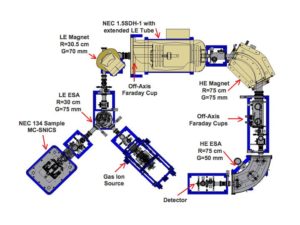Development of a Continuous-Flow AMS System
Under a NSF Major Research Instrumentation (MRI) award, NOSAMS has built a new AMS system designed specifically for continuously monitoring 14C in a flowing gas stream. The instrument is capable of continuously analyzing chromatographic effluents and determining the abundance of 14C in individual chromatographic peaks. This system will enable a dramatic expansion of significant and well-established lines of inquiry including: (i) surveys of the distribution of radiocarbon among natural products and thus of the sources of those materials, (ii) quantification of 14C tracers at extraordinary levels of dilution, and (iii) sensitive recognition of fossil-fuel-derived pollutants in natural systems by exploiting their zero content of 14C as a ‘negative label’.

The system, shown in the schematic to the right, includes chromatographic systems and other sample processing devices, couplings from these devices to the inlet of a gas-accepting ion source, and an accelerator mass spectrometer optimized for use with the ion source. The gas ion source is described elsewhere.
The center of the AMS system is a National Electrostatics Corporation (NEC), Middleton, WI, model 1.5SDH-1 accelerator. This accelerator has a slightly longer than normal low-energy acceleration tube in order to handle the
lower-energy, higher-emittance ion beam coming from the gas ion source (as compared to standard AMS Cesium sputter sources). During operation, the terminal, or center of the accelerator, is at approximately +500 kV, corresponding to the peak in the yield curve for the production of C+ from C–. At the terminal, a tapered gas-stripper canal, using Argon and operating at pressures of about 30 mTorr, is used to obtain C+ from C– and to break up interfering species such as 12CH2 and 13CH. The stripper gas is recirculated using two small turbomolecular pumps. The final energy of the C+ ion beam is about 1 MeV.

360° Panorama of the CFAMS Lab
The low energy magnet is made by Buckley Systems of Auckland, New Zealand and has a bending radius of 26.8 cm and a pole gap of 70 mm. The potential of the vacuum chamber of the analyzing magnet is biased relative to ground to allow the three isotopes of carbon to be injected sequentially into the accelerator without altering the magnetic field. At the exit of the analyzing magnet, an off-axis Faraday cup is placed along the magnet’s focal plane at the positions of mass 12 and mass 13. In the sequential-injection mode, this cup (plus two similar cups after the high-energy analyzing magnet) allows measurement of the molecular hydride component of the beam and also provides data required for calculation of the transmission efficiency of the accelerator.
At the high-energy end of the accelerator, the ion beam is momentum-analyzed by a double-focusing, 90° analyzing magnet and then energy analyzed by a double-focusing, 90° spherical electrostatic analyzer. The magnet was made by Danfysik of Jyllinge, Denmark and has a bending radius of 75 cm and a pole gap of 75 mm. The electrostatic analyzer was made by NEC and has a bending radius of 75 cm and a plate gap of 50 mm. Both the magnet and electrostatic analyzer have stigmatic focusing properties. This combination forms a mass-filtering achromat. At the exit of the analyzing magnet, two off-axis Faraday cups are placed along the magnet’s focal plane to measure 12C+ and 13C+ ion currents. At the image point of the electrostatic analyzer, the mass-filtered 14C+ ions are measured by a solid-state, silicon-surface-barrier detector. On-axis Faraday cups, beam-profile monitors, beam-defining slits, and beam-steering plates are used as needed. With the potential exception of a focusing element at the exit of the ion source, no lenses are used in the system (i.e., only the inherent focusing effect of the combined elements is used).
For device control and data acquisition we primarily use National Instruments hardware and LabVIEW software. Data acquisition includes current measurement for the stable isotope ion beams in Faraday cups and pulse-height analysis of the 14C ions. The data-acquisition package is also written in LabVIEW and generates the appropriate triggers for sample control, for the sequential-injection mode of operation, and for system calibration.
References
M.L. Roberts, K. F. Von Reden, B.X. Han, R.J. Schneider, A Benthien, and J.M. Hayes. ‘Continuous-Flow Accelerator Mass Spectrometry’, IAEA Proceedings Series, Proceedings of an International Conference, Dubrovnik, Croatia, June 5-9, 2005, IAEA-CN-115.
B.X. Han, K. F. Von Reden, M.L. Roberts, R.J. Schneider, and J.M. Hayes, ‘3-D Electromagnetic Field Modeling and Ion Optics Calculations for a Continuous-Flow AMS System’, accepted for publication in Nuclear Instruments and Methods in Physics Research B, Volume 259, Issue 1, Pages 111-117.
M.L. Roberts, R.J. Schneider, K. F. Von Reden, B.X. Han, B.E. Rosenheim, and J.M. Hayes, ‘Progress on a Gas Ion Source for Continuous-Flow Accelerator Mass Spectrometry’, Nuclear Instruments and Methods in Physics Research B, Volume 259, Issue 1, Pages 83-87.
J.S.C. Wills, B.X. Han, K.F. von Reden, R.J. Schneider, M.L. Roberts, ‘Continuous-Flow Accelerator Mass Spectrometry for Radiocarbon Analysis’, accepted for publication in the proceedings of the 27th Annual Conference of the Canadian Nuclear Society, Toronto, Ontario, June 11-14, 2006.
B.X. Han, J.R. Southon, M.L. Roberts, K.F. von Reden, ‘Computer simulation of MC-SNICS for Performance Improvements’, accepted for publication in the proceedings of the 19th International Conference on the Application of Accelerators in Research and Industry, Fort Worth, Texas, August 20-25, 2006.
K.F. von Reden, M.L. Roberts, B.X. Han, R.J. Schneider, and J.S.C. Wills, ‘Searching For A Suitable Gas Ion Source for 14C Accelerator Mass Spectrometry’, submitted for publication in the proceedings of the 11th International Symposium on the Production and Neutralization of Negative Ions and Beams, Santa Fe, New Mexico, September 13-15, 2006.
